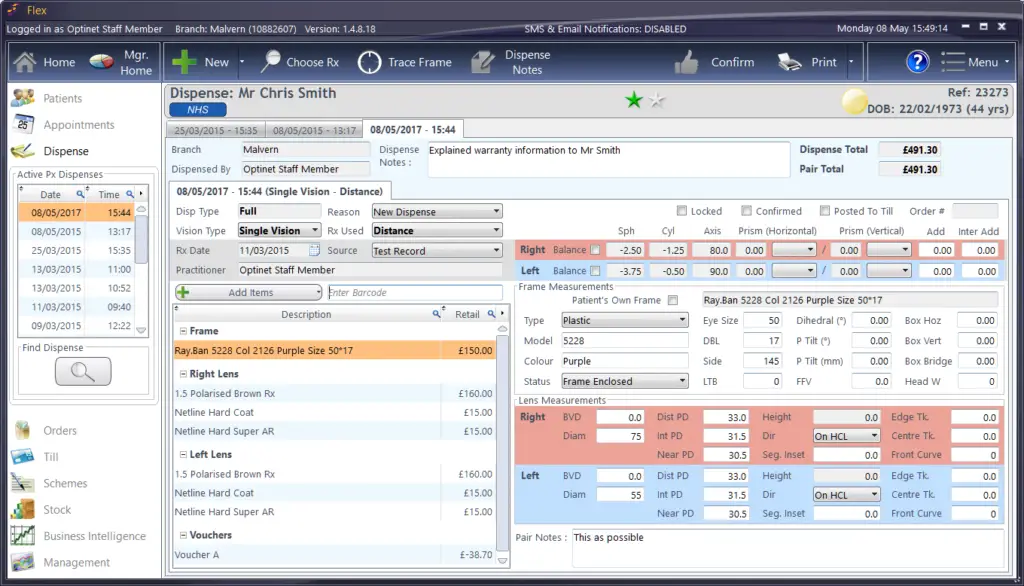What is optical inventory management software?
I’d like to introduce you to a powerful tool that can streamline your practice, improve efficiency, and enhance your patient experience – optical inventory management software. This software is tailor-made to address the unique challenges you face in your profession. Let’s explore how it can transform the way you manage your inventory.”

Foxfire EHR: A Review of the Optometry Software


OPtintuk software
1. Inventory Control: “Optical inventory management software provides you with precise control over your stock. You can effortlessly track the number of frames, lenses, and other optical supplies you have in real-time. This means you’ll never run out of essential items or have unnecessary surplus, ultimately saving you time and money.”
2. Automatic Reordering: “Say goodbye to manual reordering! The software can automatically generate purchase orders when your stock reaches a predefined threshold. This ensures you’re always well-stocked and can focus on providing the best care to your patients.”
3. Customized Alerts: “Worried about expiring or discontinued products? The software can send you alerts for items approaching their expiration dates or those that are no longer available. This helps you make informed decisions and reduce waste.”
4. Time Savings: “With optical inventory management software, you’ll free up valuable time that can be better spent on patient care, marketing your practice, or other important tasks. It automates time-consuming inventory tasks, allowing you to be more efficient.”
5. Enhanced Patient Experience: “Optical inventory management software also indirectly benefits your patients. When you’re well-stocked and organized, you can provide faster service, better product recommendations, and a seamless overall experience.”
6. Reporting and Analytics: “Gain insights into your inventory trends and sales data with detailed reports and analytics. This can help you make informed decisions about which products to carry and identify your best-selling items.”
7. Cost Savings: “By reducing overstock and minimizing waste, you can significantly cut down on inventory costs. This means more money in your pocket and potentially lower prices for your patients.”
Optometry inventory management is the process of tracking and controlling the products and services that an optometry practice offers to its patients. Inventory management is essential for optimising the profitability, efficiency, and customer satisfaction of an optometry practice. In this article, we will discuss some of the benefits, challenges, and best practices of optometry inventory management.
American Optometric Association Malpractice Insurance
Finding the best Ophthalmology billing company
Benefits of Optometry Inventory Management
Do optical shop retailers need an inventory management system?
Optometry inventory management can provide several benefits to an optometry practice, such as:
- Increasing sales and revenue by offering a variety of products and services that meet the needs and preferences of different customer segments.
- Reducing costs and waste by avoiding overstocking or understocking of products, minimizing inventory shrinkage, and negotiating better terms and prices with vendors.
- Improving customer satisfaction and loyalty by ensuring product availability, quality, and freshness, providing timely delivery and service, and offering discounts and incentives
- Enhancing competitive advantage by staying updated with industry trends, customer demands, and market opportunities, and differentiating the practice from other competitors
Challenges of Optometry Inventory Management
Optometry inventory management can also pose some challenges to an optometry practice, such as:
- Managing a large and diverse inventory of frames, contact lenses, spectacle lenses, lens treatments, services, and other items for a single shop or multiple branches.
- Balancing the trade-off between inventory holding costs and inventory shortage costs, which can affect the cash flow and profitability of the practice.
- Dealing with external factors such as seasonality, demand fluctuations, vendor reliability, warranty issues, and insurance processing and billing.
- Keeping track of inventory performance metrics such as turn ratio, sell-through rate, gross margin return on investment, and inventory turnover ratio.
Best Practices of Optometry Inventory Management
To overcome the challenges and maximize the benefits of optometry inventory management, an optometry practice can adopt some of the following best practices:
- Know the customer, industry, and office needs by conducting market research, analyzing customer demographics, preferences, and feedback, understanding industry trends in frames, colors, styles, and designers, and defining the office’s goals, budget, and policies.
- Segment and categorize the inventory by designers and brands to create a perception of choice for the customers and facilitate easy browsing and selection. Alternatively, use other criteria such as price range, target market, or frame type to segment the inventory according to the practice’s strategy.
- Select the right products by evaluating the quality, price, popularity, warranty, and co-op terms of different vendors and brands.
- Use data from previous sales history, industry reports, vendor feedback, and customer surveys to identify the best-selling and most profitable products.
- Control the inventory level by using inventory management software or systems that can track inventory movement, notify low stock levels, facilitate easy ordering and replenishment, compare vendor pricing and terms, generate reports and analytics
- Aim for an optimal inventory turn ratio of at least four times per year.
- Monitor and evaluate the inventory performance by using key performance indicators (KPIs) such as sales volume, revenue, gross margin, cost of goods sold (COGS), inventory holding cost (IHC), inventory shortage cost (ISC), turn ratio (TR), sell-through rate (STR), gross margin return on investment (GMROI), and inventory turnover ratio (ITR).
- Use these metrics to identify strengths and weaknesses in the inventory management process and make adjustments accordingly.
Optometry inventory management is a vital aspect of running a successful optometry practice. By following some of the benefits, challenges, and best practices discussed in this article, an optometry practice can optimize its inventory management process and achieve higher sales revenue.
Follow us in Facebook
